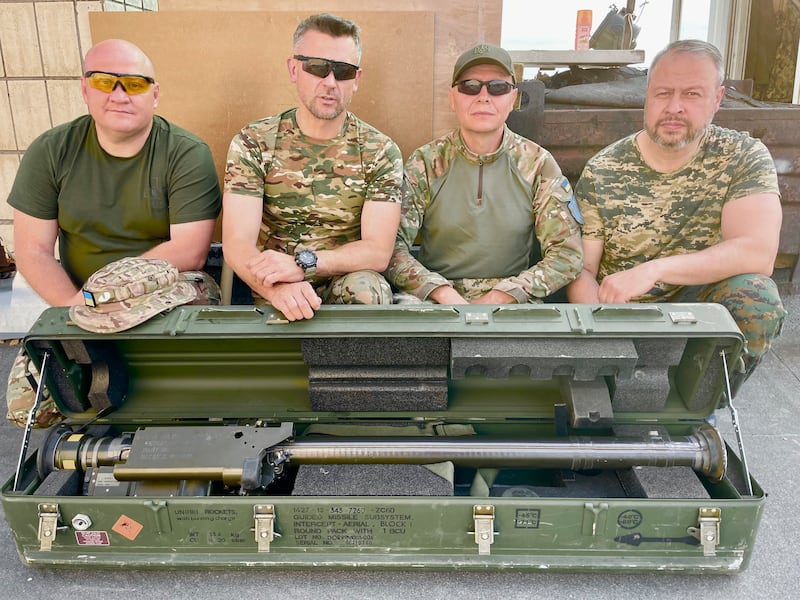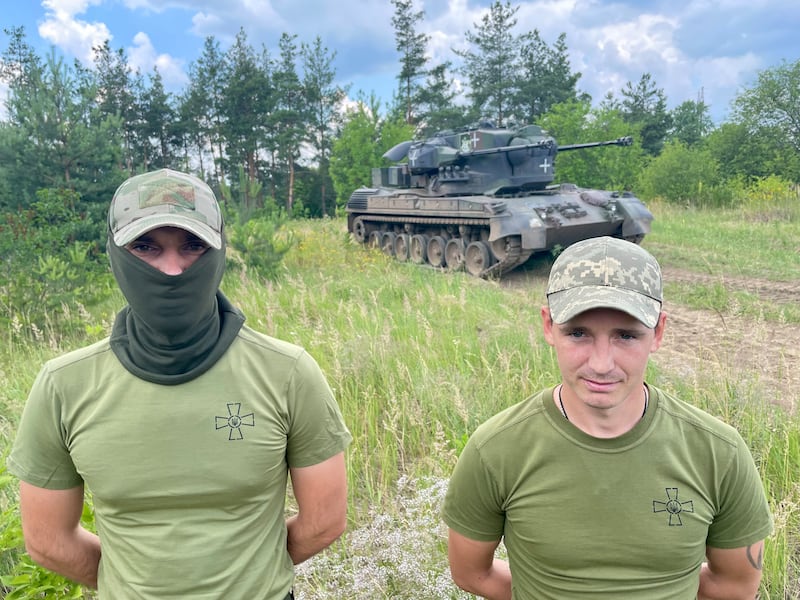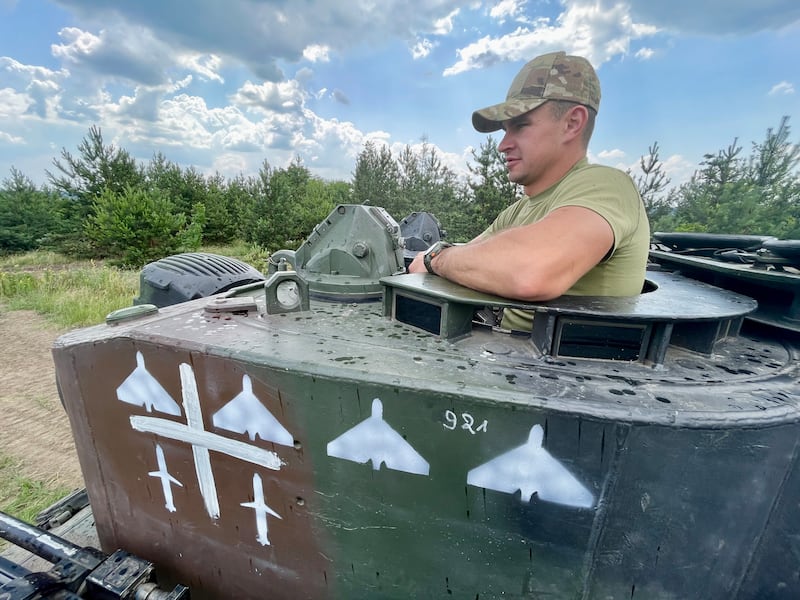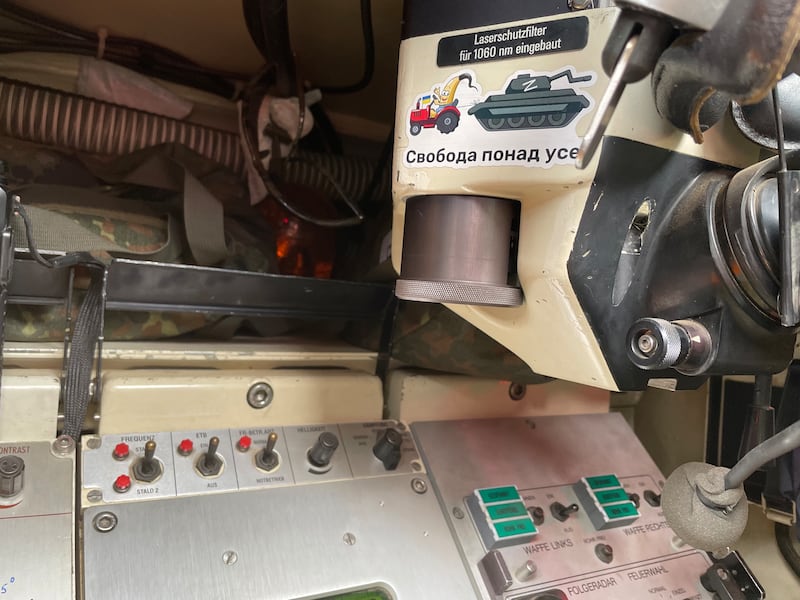High on a tower block overlooking the outskirts of Kyiv and the glinting Dnipro river, a volunteer unit founded by senior judges has watched the city’s air defences evolve into a formidable shield, while doing their own bit to protect the Ukrainian capital.
The judges established the Mriya (Dream) battalion when Russia launched its invasion of Ukraine 16 months ago, and its role has changed as the war has ground on and the threat from Moscow’s vast military has shifted.
When Russian troops tried to seize Kyiv in the first weeks of the war, Mriya members guarded strategic buildings in the capital to free up experienced soldiers for frontline duties. Then they protected a stadium in the city to ensure enemy paratroopers could not land there.
The unit’s focus shifted last autumn, when Russia began targeting Ukrainian cities with swarms of Iranian-made Shahed drones – dubbed “kamikaze” or “suicide” drones because they explode on impact – in a bid to cripple the country’s power grid during the freezing winter months.
The Russian drone strikes continue, killing and injuring people every week, alongside a campaign of almost nightly missile attacks against Ukrainian military, infrastructure and civilian sites.

“Around Kyiv, I think we have every kind of air defence system in Ukraine – Patriots, Gepards, Nasams and others,” says supreme court judge Vitaliy Zuyev, referring to powerful anti-aircraft weapons provided by the United States, Germany and Norway, respectively.
“From up here we see them all working. And we are a very small part of that, too.”
Ukraine has also taken delivery of high-tech Crotale systems from France, the Iris-T from Germany and the Italian-French Aster, as well as smaller vehicle-mounted weapons including the US Avenger, and so-called man-portable anti-aircraft missiles such as the US Stinger, Poland’s Piorun and Britain’s Starstreak, to dramatically bolster its own ageing arsenal of Soviet-era rockets.
The aim has been to create “layered defence” of the airspace over Kyiv and other major cities and around key military facilities, capable of downing an array of Russian threats flying at different speeds and altitudes. The upshot is that Ukraine now has one of the most advanced air defence networks in the world, and probably the most varied.
Last month alone, Ukraine’s air force reportedly shot down 149 cruise missiles, 399 drones, three ballistic missiles and 11 Iskander rockets. The Patriots even intercepted seven of the Kinzhal missiles that the Kremlin claimed were unstoppable – the first time they are known to have been shot down.
The learning curve has been steep for individual air defence crews and for the Ukrainian military as a whole, as it raced to integrate the many elements of the system.

Roman, Oleksandr and Oleksiy make up a three-man crew of the tank-like Gepard (Cheetah) system, which weighs about 45 tonnes, is highly manoeuvrable and carries a radar that can spot threats from 15km away and destroy them from 3km with swivelling twin guns that unleash streams of 35mm shells.
“We went to Germany for an accelerated training course of six weeks,” says Oleksiy, who was a barman in the eastern Ukrainian city of Dnipro until last year. “It was surprisingly easy to pick everything up. We had good trainers who taught us very well. And they said we were the best crew they’d trained.”
Oleksandr, a builder in the eastern Kharkiv region before the war, says that most nights and some days their Gepard is put on alert, and engages any Russian threat that comes within range. “We’re 100 per cent effective against Shaheds and pretty good against cruise missiles too,” he adds. “If something flies into our area, we’ll shoot it down.”

The Gepard was introduced in 1976 and, after many upgrades, seemed to be heading for retirement before being given a new lease of life by the war in Ukraine. Kyiv’s military values its ruggedness, mobility, and weapons systems that could have been designed specifically to destroy the low-flying, slow-moving Shaheds that Iran is supplying to Russia by the hundreds. It is also relatively cheap to operate, allowing the military to save more expensive air defence missiles for harder-to-hit targets.
The crew is keeping a count of their “kills” on the side of this Gepard, and it currently stands at four Shaheds and two cruise missiles – potentially saving many lives and millions of euro in damage in Kyiv.
“You see the target on the screen, aim with the joystick and press a pedal to fire,” explains Roman, the crew’s commander, as he sits at the Gepard’s controls. “The noise and vibration in here when we shoot is impressive.”

A Ukrainian sticker near the control panel says “Svoboda ponad use” – “Freedom above all else”. Roman looks at it and says: “That’s what all this is about.”
Tucked into a thicket of trees outside a sleepy village about an hour’s drive from Kyiv, a passerby could easily not notice the camouflaged Gepard. In action, however, it unleashes a thunderous burst of shells that glow red in the night sky.
The judges have seen Gepards engaging targets from their Kyiv rooftop, where their own armoury is more modest.
They have Kalashnikov rifles, a 1944 Maxim machine gun and a Czechoslovak machine gun from the 1960s, and their pride and joy – a shoulder-launched Stinger that the military has taught some of them how to use.
They also have radios through which the military alerts them to any threats in their area, and a tablet computer on which they can see real-time information on the location of drones and missiles.
They pay for upgrades or “extras” with their own money, including a $3,500 (€3,220) night-vision scope with a laser that a spotter can use to pinpoint a drone for his gunner.
“Frankly speaking, what we can shoot is Shaheds. Cruise missiles fly at 850km/h, and we’ve seen them, but of course that’s too fast for us,” says supreme court judge Yuriy Chumak. “We’re also limited in where we can shoot,” he adds, pointing to markings on the rooftop that show the areas they can fire safely without endangering any buildings.
They only engage a target that is in range and in the permitted zone, and they have opened fire just a handful of times since last autumn – although another Mriya unit on a different Kyiv rooftop did shoot down a Shahed with a machine gun.
“You can definitely hit a Shahed with an expensive missile, but why do that if there are cheaper ways?” asks Zuyev.
“We didn’t create this unit for air defence, it was created to defend Kyiv. But this is now our task,” Chumak adds. “We started on one rooftop and now we’re on five. And for our military we are cheap – they don’t pay us, they give us old guns and bullets, and we organise everything else.”
This is also just one element of the work of the Mriya volunteer battalion, which still includes about 30 judges: it also provides vehicles and equipment to frontline troops, and about 200 of its members have gone on to become professional soldiers in Ukraine’s army.
“We spend our time and money on defence ... But the guys on the front line are doing so much more than we are, they are risking their lives every day,” says Chumak, who has lost two former classmates to the war.
“Everyone now has friends, relatives and school and university classmates who have been killed,” Zuyev adds. “Every time it happens you feel that you’re not doing enough. But we’re trying to do something.”




















